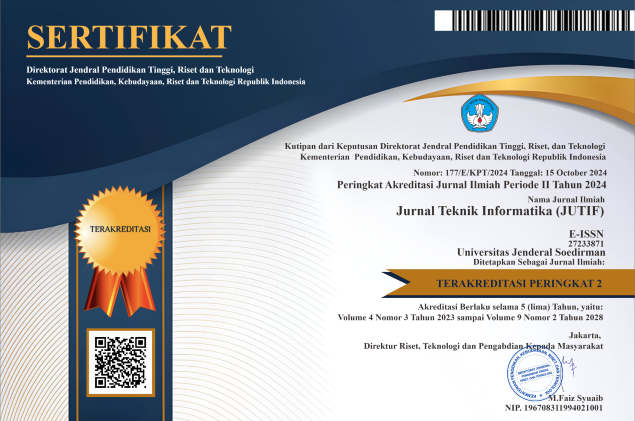Rainfall Forecasting Using SSA-Based Hybrid Models with LSSVR and LSTM for Disaster Mitigation
DOI:
https://doi.org/10.52436/1.jutif.2025.6.4.4963Keywords:
LSSVR, LSTM, NMF, Rainfall Prediction, Spatial Visualization, SSAAbstract
Accurate rainfall forecasting is crucial for addressing the increasing risk of hydrometeorological disasters, particularly in tropical regions such as Semarang City, Indonesia. However, conventional forecasting models often struggle with inaccurate data and observations. This study proposes a novel hybrid combination of SSA-NMF with LSSVR and LSTM, offering high-resolution rainfall forecasting over multiple monitoring stations, to predict daily rainfall. As a preprocessing step, 15 years of daily rainfall data from six observation stations were denoised and decomposed using Singular Spectrum Analysis (SSA) combined with Non-Negative Matrix Factorization (NMF). This approach effectively handled data with many zero values, identified seasonal patterns or high-rainfall locations, and extracted key patterns. The prediction models were trained and validated using parameters optimized through RandomizedSearchCV for LSSVR and Keras Tuner for LSTM. Model performance was evaluated using MSE, RMSE, MAE, and Nash-Sutcliffe Efficiency (NSE). The results showed that the SSA-LSTM model consistently outperformed SSA-LSSVR model, with the highest average NSE value being 0.9 across six monitoring locations in Semarang City. Furthermore, the predicted rainfall values were spatially visualized using Inverse Distance Weighting (IDW) interpolation within a Geographic Information System (GIS) environment, producing informative rainfall distribution maps that support early warning systems and disaster mitigation efforts. In conclusion, the hybrid approach combining SSA-NMF preprocessing with LSTM-based deep learning significantly improves the accuracy and reliability of daily rainfall forecasting. This novel SSA‑NMF + LSSVR/LSTM framework delivers high‑resolution, reliable rainfall forecasts that directly empower disaster risk reduction systems and readily transfer to similar climatic regions.
Downloads
References
M. Alfandi and A. M. H. Sihite, “Penerapan Metode CNN-LSTM Dalam Memprediksi Hujan Pada Wilayah Medan,” Nas. Teknol. Inf. dan Komputer), vol. 6, no. 1, pp. 490–499, 2022, doi: 10.30865/komik.v6i1.5713.
S. M. Shaharudin, N. Ahmad, and N. H. Zainuddin, “Modified Singular Spectrum Analysis In Identifying Rainfall Trend Over Peninsular Malaysia,” Indones. J. Electr. Eng. Comput. Sci., vol. 15, no. 1, pp. 283–293, 2019, doi: 10.11591/ijeecs.v15.i1.pp283-293.
P. C. S. Reddy, Y. Sucharitha, and G. S. Narayana, “Development of Rainfall Forecasting Model Using Machine Learning With Singular Spectrum Analysis,” IIUM Eng. J., vol. 23, no. 1, pp. 172–186, 2022, doi: 10.31436/IIUMEJ.V23I1.1822.
F. Fitri, R. Rahmat, and A. D. Pengestuti, “Forecasting of Rainfall in Sumatera Barat: Singular Spectrum Analysis (SSA) Application,” J. Phys. Conf. Ser., vol. 1554, no. 1, 2020, doi: 10.1088/1742-6596/1554/1/012047.
P. O. Bojang, T. C. Yang, Q. B. Pham, and P. S. Yu, “Linking Singular Spectrum Analysis And Machine Learning For Monthly Rainfall Forecasting,” Appl. Sci., vol. 10, no. 9, 2020, doi: 10.3390/app10093224.
O. O. Awe, R. Mahmoudvand, and P. C. Rodrigues, “Non-Negative Time Series Reconstruction via Singular Spectrum Analysis: A Case Study of Precipitation Dynamics in Nigeria,” Fluct. Noise Lett., vol. 19, no. 4, pp. 1–21, 2020, doi: 10.1142/S0219477520500455.
A. D. Nguyen et al., “Accurate Discharge And Water Level Forecasting Using Ensemble Learning With Genetic Algorithm And Singular Spectrum Analysis-Based Denoising,” Sci. Rep., vol. 12, no. 1, pp. 1–25, 2022, doi: 10.1038/s41598-022-22057-8.
X. Zhang, J. Wang, and Y. Gao, “A Hybrid Short-Term Electricity Price Forecasting Framework: Cuckoo Search-Based Feature Selection With Singular Spectrum Analysis And SVM,” Energy Econ., vol. 81, pp. 899–913, 2019, doi: 10.1016/j.eneco.2019.05.026.
W. Xin, L. Xingke, W. Jiantao, S. Yun, L. Ying, and W. Tingshu, “A Trend Prediction Method for Failures Time Series Data by Exploring Singular Spectrum Analysis and Support Vector Machines Regression,” Proc. IEEE 7th Int. Conf. Comput. Sci. Netw. Technol. ICCSNT 2019, pp. 535–541, 2019, doi: 10.1109/ICCSNT47585.2019.8962511.
A. Habib, R. Abbassi, A. J. Aristizábal, and A. Abbassi, “Forecasting Model For Wind Power Integrating Least Squares Support Vector Machine, Singular Spectrum Analysis, Deep Belief Network, And Locality-Sensitive Hashing,” Wind Energy, vol. 23, no. 2, pp. 235–257, 2020, doi: 10.1002/we.2425.
H. Zhang et al., “A Combined Model Based On SSA, Neural Networks, And LSSVM For Short-Term Electric Load And Price Forecasting,” Neural Comput. Appl., vol. 33, no. 2, pp. 773–788, 2021, doi: 10.1007/s00521-020-05113-0.
S. Zhang, C. Liu, W. Wang, and B. Chang, “Twin Least Square Support Vector Regression Model Based On Gauss-Laplace Mixed Noise Feature With Its Application In Wind Speed Prediction,” Entropy, vol. 22, no. 10, pp. 1–19, 2020, doi: 10.3390/e22101102.
N. Neeraj, J. Mathew, M. Agarwal, and R. K. Behera, “Long Short-Term Memory-Singular Spectrum Analysis-Based Model For Electric Load Forecasting,” Electr. Eng., vol. 103, no. 2, pp. 1067–1082, 2021, doi: 10.1007/s00202-020-01135-y.
J. Zhao, R. Cai, and W. Sun, “Regional Sea Level Changes Prediction Integrated With Singular Spectrum Analysis And Long-Short-Term Memory Network,” Adv. Sp. Res., vol. 68, no. 11, pp. 4534–4543, 2021, doi: 10.1016/j.asr.2021.08.017.
A. Y. Barrera-Animas, L. O. Oyedele, M. Bilal, T. D. Akinosho, J. M. D. Delgado, and L. A. Akanbi, “Rainfall Prediction: A Comparative Analysis Of Modern Machine Learning Algorithms For Time-Series Forecasting,” Mach. Learn. with Appl., vol. 7, no. November 2021, p. 100204, 2022, doi: 10.1016/j.mlwa.2021.100204.
O. A. Wani et al., “Predicting Rainfall Using Machine Learning, Deep Learning, And Time Series Models Across An Altitudinal Gradient In The North-Western Himalayas,” Sci. Rep., vol. 14, no. 1, 2024, doi: 10.1038/s41598-024-77687-x.
J. Lei, Q. Quan, P. Li, and D. Yan, “Research On Monthly Precipitation Prediction Based On The Least Square Support Vector Machine With Multi-Factor Integration,” Atmosphere (Basel)., vol. 12, no. 8, 2021, doi: 10.3390/atmos12081076.
P. Saeipourdizaj, P. Sarbakhsh, and A. Gholampour, “Application Of Imputation Methods For Missing Values Of Pm10 And O3 Data: Interpolation, Moving Average And K-Nearest Neighbor Methods,” Environ. Heal. Eng. Manag., vol. 8, no. 3, pp. 215–226, 2021, doi: 10.34172/EHEM.2021.25.
A. Widianti and I. Pratama, “Penanganan Missing Values Dan Prediksi Data Timbunan Sampah Berbasis Machine Learning,” vol. 9, no. 2, pp. 242–251, 2024, doi: https://doi.org/10.36341/rabit.v9i2.4789.
A. H. Mauladha and W. Astuti, “Perbandingan Teknik Penanganan Missing Value Dalam Klasifikasi Penyakit Diabetes Menggunakan Metode Naïve Bayes,” vol. 2, no. 5, pp. 1–14, 2021.
Gde Agung Brahmana Suryanegara, Adiwijaya, and Mahendra Dwifebri Purbolaksono, “Peningkatan Hasil Klasifikasi pada Algoritma Random Forest untuk Deteksi Pasien Penderita Diabetes Menggunakan Metode Normalisasi,” J. RESTI (Rekayasa Sist. dan Teknol. Informasi), vol. 5, no. 1, pp. 114–122, 2021, doi: 10.29207/resti.v5i1.2880.
S. Smyl, “A Hybrid Method Of Exponential Smoothing And Recurrent Neural Networks For Time Series Forecasting,” Int. J. Forecast., vol. 36, no. 1, pp. 75–85, 2020, doi: 10.1016/j.ijforecast.2019.03.017.
N. Golyandina, V. Nekrutkin, and A. A. Zhigljavsky, Analysis of Time Series Structure SSA and Related Techniques. Boca Raton, Florida: Chapman & Hall/CRC, 2001. doi: 10.1198/004017002320256477.
Y. Wang, S. Sun, and Z. Cai, “Daily Peak-Valley Electric-Load Forecasting Based on an SSA-LSTM-RF Algorithm,” Energies, vol. 16, no. 24, 2023, doi: 10.3390/en16247964.
J. A. K. Suykens and J. Vandewalle, “Least Squares Support Vector Machine Classifiers,” Neural Process. Lett., vol. 9, pp. 293–300, 1999, doi: https://doi.org/10.1023/A:1018628609742.
R. Chen, C. Y. Liang, W. C. Hong, and D. X. Gu, “Forecasting Holiday Daily Tourist Flow Based On Seasonal Support Vector Regression With Adaptive Genetic Algorithm,” Appl. Soft Comput., vol. 26, pp. 435–443, 2015, doi: 10.1016/j.asoc.2014.10.022.
J. Huang, Y. Bo, and H. Wang, “Electromechanical Equipment State Forecasting Based On Genetic Algorithm - Support Vector Regression,” Expert Syst. Appl., vol. 38, no. 7, pp. 8399–8402, 2011, doi: 10.1016/j.eswa.2011.01.033.
J. H. Min and Y. C. Lee, “Bankruptcy Prediction Using Support Vector Machine With Optimal Choice Of Kernel Function Parameters,” Expert Syst. Appl., vol. 28, no. 4, pp. 603–614, 2005, doi: 10.1016/j.eswa.2004.12.008.
H. Xiang, Y. Li, H. Liao, and C. Li, “An Adaptive Surrogate Model Based On Support Vector Regression And Its Application To The Optimization Of Railway Wind Barriers,” Struct. Multidiscip. Optim., vol. 55, no. 2, pp. 701–713, 2017, doi: 10.1007/s00158-016-1528-9.
C. Yan, X. Shen, and F. Guo, “An Improved Support Vector Regression Using Least Squares Method,” Struct. Multidiscip. Optim., vol. 57, no. 6, pp. 2431–2445, 2018, doi: 10.1007/s00158-017-1871-5.
H. Nuha, “Mean Squared Error (MSE) dan Penggunaannya,” Papers.Ssrn.Com, vol. 52, pp. 1–1, 2023, [Online]. Available: https://ssrn.com/abstract=4420880 Accessed: Jun. 18, 2025
T. O. Hodson, “Root-Mean-Square Error (RMSE) Or Mean Absolute Error (MAE): When To Use Them Or Not,” Geosci. Model Dev., vol. 15, no. 14, pp. 5481–5487, 2022, doi: 10.5194/gmd-15-5481-2022.
H. V. Gupta and H. Kling, “On Typical Range, Sensitivity, And Normalization Of Mean Squared Error And Nash-Sutcliffe Efficiency Type Metrics,” Water Resour. Res., vol. 47, no. 10, pp. 2–4, 2011, doi: 10.1029/2011WR010962.
R. le Roux, S. Henrico, J. Bezuidenhout, and I. Henrico, “Inverse Distance Weighting As An Alternative Interpolation Method To Create Radiometric Maps Of Natural Radionuclide Concentrations Using QGIS,” Proc. ICA, vol. 5, no. August, pp. 1–7, 2023, doi: 10.5194/ica-proc-5-10-2023.
H. Liu, W. Liu, J. Luo, and J. Li, “Comparative Study of Multi-Combination Models for Medium- and Long-Term Runoff Prediction in Weihe River,” IEEE Access, vol. 11, pp. 97099–97106, 2023, doi: 10.1109/ACCESS.2023.3312185.
Additional Files
Published
How to Cite
Issue
Section
License
Copyright (c) 2025 Zauyik Nana Ruslana, Eri Zuliarso

This work is licensed under a Creative Commons Attribution 4.0 International License.



























